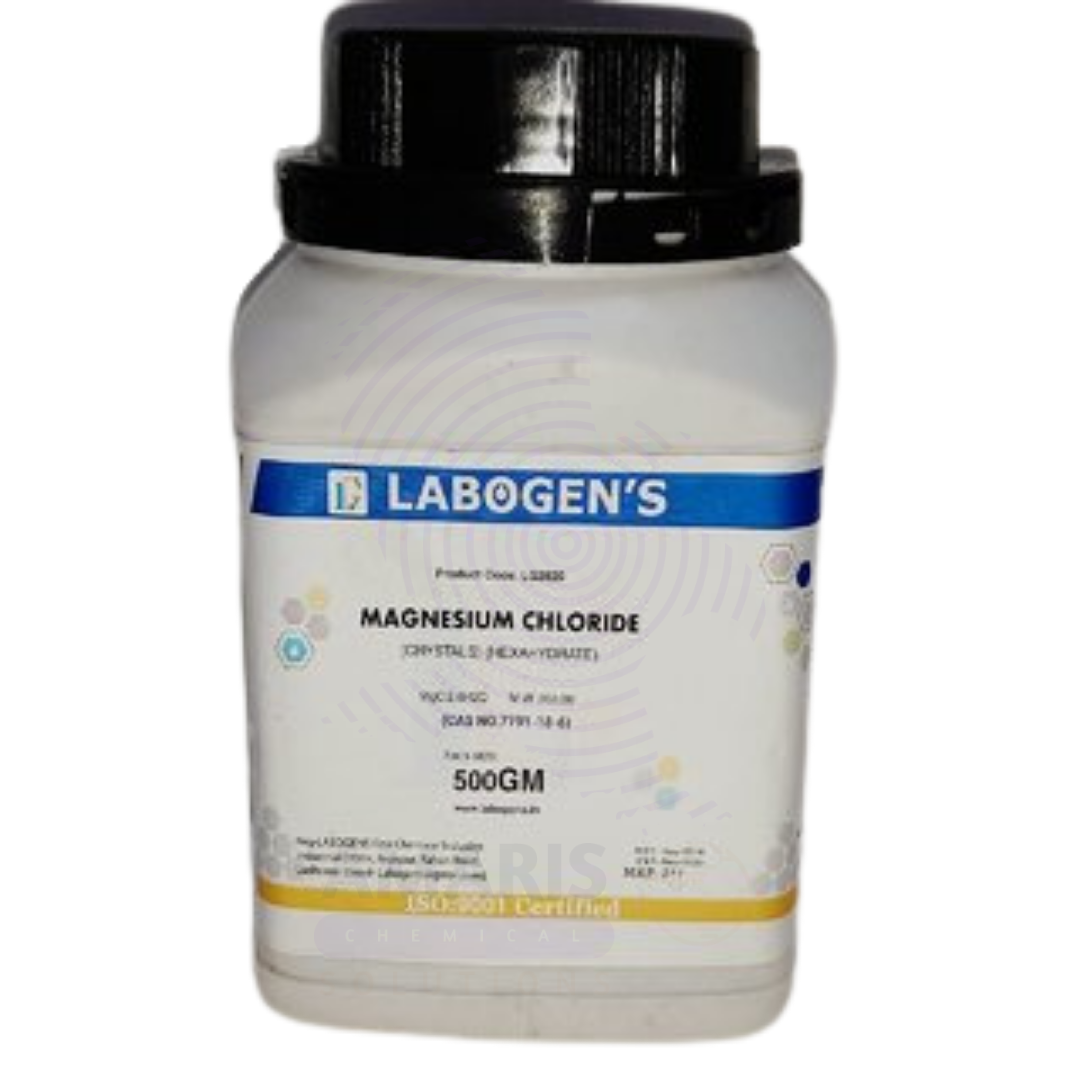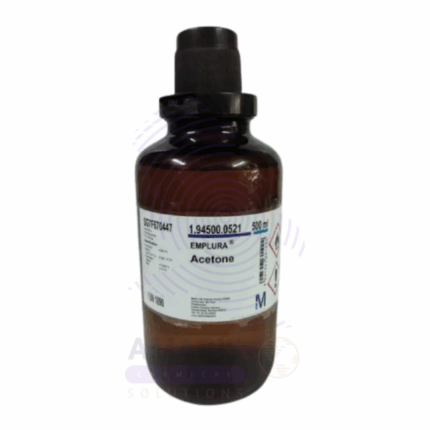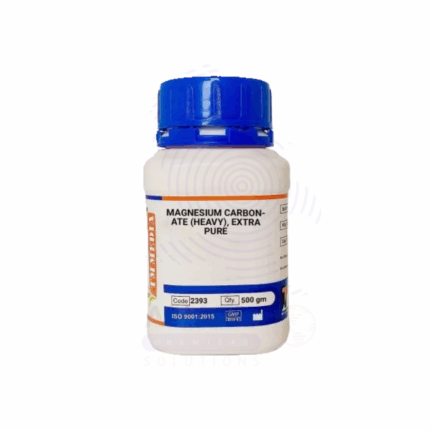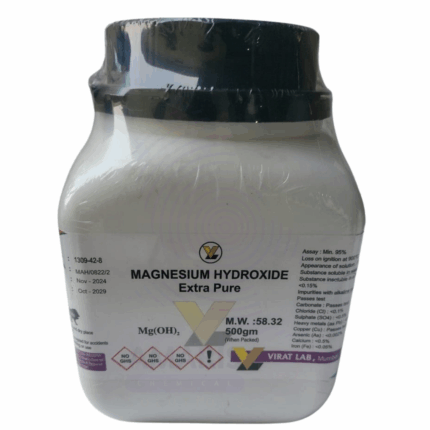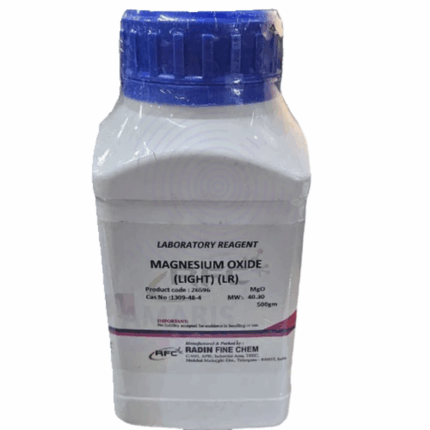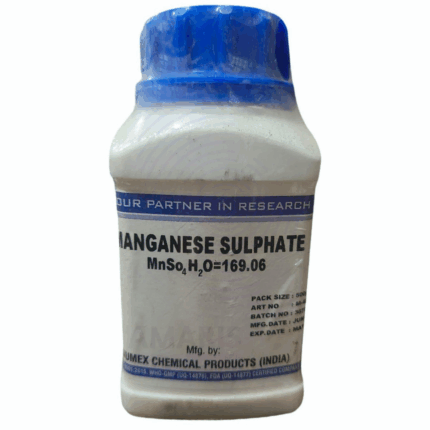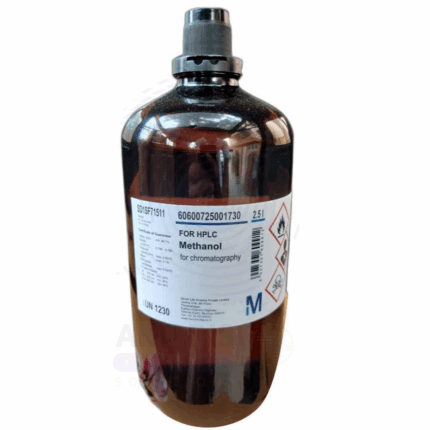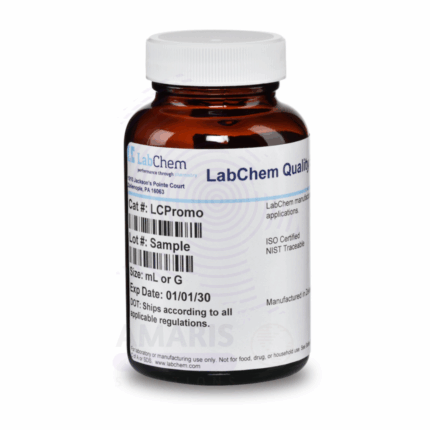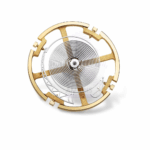
Magnesium Chloride Extra Pure
$ 17.30 Original price was: $ 17.30.$ 17.23Current price is: $ 17.23.
Magnesium Chloride Extra Pure is a highly soluble, refined chemical compound commonly used for its excellent hygroscopic and electrolyte properties. In laboratory and analytical settings, it is valued for preparing magnesium-based solutions and as a reagent in various chemical reactions. In pharmaceuticals, it serves as a magnesium supplement, aiding in nerve function and muscle health. It is also used in cosmetics and personal care products for its skin-conditioning benefits. Additionally, it finds applications in textile processing, dust control, and de-icing formulations, where its purity ensures minimal impurities in sensitive applications.
Magnesium Chloride Extra Pure
Primary Uses
- Reagent in Analytical Chemistry:
- Used in qualitative and quantitative analysis involving magnesium or chloride ions.
- Precursor in Salt Formation Reactions:
- Acts as a starting material in the preparation of other magnesium salts through double displacement reactions.
- Source of Magnesium Ions:
- Provides Mg²⁺ ions for biochemical experiments, cell culture media, and ionic strength adjustment.
Secondary Uses
- Electrolyte in Electrochemistry:
- Used in conductivity experiments and electrochemical cells due to its solubility and ionic properties.
- Desiccant in Controlled Environments:
- Helps in moisture control as part of some desiccant formulations.
- Heat Pack Demonstrations:
- Sometimes included in exothermic reaction demonstrations, such as crystallization or dissolving in water.
| PACK SIZE |
500 grams Plastic Tin |
|---|
1. Basic Identification Attributes
- Chemical Name: Magnesium Chloride
- Synonyms: Magnesium dichloride, Magnesium chloride hexahydrate (if hydrated)
- CAS Number:
- Anhydrous: 7786-30-3
- Hexahydrate: 7791-18-6
- Molecular Formula:
- Anhydrous: MgCl₂
- Hexahydrate: MgCl₂·6H₂O
- Molecular Weight:
- Anhydrous: 95.21 g/mol
- Hexahydrate: 203.30 g/mol
- Appearance: White or colorless crystalline solid
- Odor: Odorless
- Solubility: Highly soluble in water
- Grade: Extra Pure (suitable for high-purity lab applications)
2. Safety & Hazard Attributes
- GHS Classification:
- Not classified as hazardous under GHS for general laboratory use
- Hazard Statements:
- None required for Extra Pure grade under normal lab handling
- Precautionary Statements:
- P280: Wear protective gloves, eye protection
- P264: Wash hands thoroughly after handling
- P305+P351+P338: IF IN EYES, rinse cautiously with water for several minutes
- Personal Protective Equipment (PPE):
- Safety goggles
- Gloves
- Lab coat
- Dust mask (if powdered form is handled)
- First Aid Measures:
- Inhalation: Move to fresh air; seek medical attention if symptoms persist
- Skin Contact: Wash off with soap and water
- Eye Contact: Rinse thoroughly with water for several minutes
- Ingestion: Rinse mouth; drink water; seek medical attention if discomfort occurs
- Fire Hazards:
- Not flammable
- Use extinguishing media suitable for surrounding fire
3. Storage & Handling Attributes
- Storage Conditions:
- Store tightly closed in a dry place
- Avoid exposure to moisture (hygroscopic)
- Store away from incompatible materials (e.g., strong oxidizers)
- Handling Tips:
- Avoid creating dust
- Wash hands after use
- Use in well-ventilated areas
4. Laboratory Applications
- Primary Uses:
- Source of magnesium ions in analytical chemistry
- Reagent in titration and complexometric analysis
- Electrolyte preparation for electrochemical studies
- Secondary Uses:
- Dehydration experiments (when using the hydrated form)
- Thermal decomposition studies
- Buffer preparation in biological and biochemical labs
SAFETY PRECAUTIONS
Personal Protective Equipment (PPE):
- Wear a lab coat, nitrile gloves, and protective goggles.
- Use a dust mask if working with powdered form or ensure adequate ventilation.
Handling:
- Avoid contact with skin, eyes, and clothing.
- Prevent formation and inhalation of dust or aerosols.
- Wash hands thoroughly after handling.
Storage:
- Store in a cool, dry, and well-ventilated area.
- Keep the container tightly sealed.
- Protect from moisture and incompatible substances like strong oxidizing agents.
FIRST AID MEASURES
Inhalation:
- Move the person to fresh air immediately.
- Seek medical attention if breathing becomes difficult.
Skin Contact:
- Wash affected area with plenty of water and soap.
- Remove contaminated clothing.
- Get medical attention if irritation occurs.
Eye Contact:
- Rinse thoroughly with clean water for several minutes.
- Remove contact lenses if present and easy to do.
- Continue rinsing and consult a doctor if irritation persists.
Ingestion:
- Rinse mouth with water.
- Do not induce vomiting.
- Seek medical advice, especially if symptoms such as nausea or abdominal discomfort occur.
FIRE FIGHTING MEASURES
Flammability:
- Non-flammable.
Extinguishing Media:
- Use water spray, dry chemical, foam, or carbon dioxide (CO₂).
- Choose an extinguishing method suitable for surrounding fire.
Hazardous Combustion Products:
- May emit hydrogen chloride and magnesium oxides upon decomposition in fire.
Firefighter Protection:
- Use self-contained breathing apparatus (SCBA) and full protective clothing.


 Preservatives(food)
Preservatives(food) Flavor Enhancers
Flavor Enhancers Acidulants
Acidulants Sweeteners
Sweeteners Antioxidants
Antioxidants Colorants(food)
Colorants(food) Nutraceutical Ingredients (food)
Nutraceutical Ingredients (food) Nutrient Supplements
Nutrient Supplements Emulsifiers
Emulsifiers
 Collectors
Collectors Dust Suppressants
Dust Suppressants Explosives and Blasting Agents
Explosives and Blasting Agents Flocculants and Coagulants
Flocculants and Coagulants Frothers
Frothers Leaching Agents
Leaching Agents pH Modifiers
pH Modifiers Precious Metal Extraction Agents
Precious Metal Extraction Agents
 Antioxidants(plastic)
Antioxidants(plastic) Colorants (Pigments, Dyes)
Colorants (Pigments, Dyes) Fillers and Reinforcements
Fillers and Reinforcements Flame Retardants
Flame Retardants Monomers
Monomers Plasticizers
Plasticizers Polymerization Initiators
Polymerization Initiators Stabilizers (UV, Heat)
Stabilizers (UV, Heat)
 Antifoaming Agents
Antifoaming Agents Chelating Agents
Chelating Agents Coagulants and Flocculants
Coagulants and Flocculants Corrosion Inhibitors
Corrosion Inhibitors Disinfectants and Biocides
Disinfectants and Biocides Oxidizing Agents
Oxidizing Agents pH Adjusters
pH Adjusters Scale Inhibitors( water)
Scale Inhibitors( water)
 Antioxidants(cosmetic)
Antioxidants(cosmetic) Emollients
Emollients Fragrances and Essential Oils
Fragrances and Essential Oils Humectants
Humectants Preservatives
Preservatives Surfactants(cosmetic)
Surfactants(cosmetic) Thickeners
Thickeners UV Filters
UV Filters
 Fertilizers
Fertilizers Soil Conditioners
Soil Conditioners Plant Growth Regulators
Plant Growth Regulators Animal Feed Additives
Animal Feed Additives Biostimulants
Biostimulants Pesticides (Herbicides, Insecticides, Fungicides)
Pesticides (Herbicides, Insecticides, Fungicides)
 Active Pharmaceutical Ingredients (APIs)
Active Pharmaceutical Ingredients (APIs) Excipients
Excipients Solvents(pharmaceutical)
Solvents(pharmaceutical) Antibiotics
Antibiotics Antiseptics and Disinfectants
Antiseptics and Disinfectants Vaccine Adjuvants
Vaccine Adjuvants Nutraceutical Ingredients (pharmaceutical)
Nutraceutical Ingredients (pharmaceutical) Analgesics & Antipyretics
Analgesics & Antipyretics
 Analytical Reagents
Analytical Reagents Solvents(lab)
Solvents(lab) Chromatography Chemicals
Chromatography Chemicals Spectroscopy Reagents
Spectroscopy Reagents microbiology-and-cell-culture-reagents
microbiology-and-cell-culture-reagents Molecular Biology Reagents
Molecular Biology Reagents Biochemical Reagents
Biochemical Reagents Inorganic and Organic Standards
Inorganic and Organic Standards Laboratory Safety Chemicals
Laboratory Safety Chemicals Specialty Laboratory Chemicals(Special Laboratory Equipment)
Specialty Laboratory Chemicals(Special Laboratory Equipment)
 Demulsifiers
Demulsifiers Hydraulic Fracturing Fluids
Hydraulic Fracturing Fluids Scale Inhibitors(oil)
Scale Inhibitors(oil) Surfactants(oil)
Surfactants(oil) Drilling Fluids
Drilling Fluids
 Dyes and Pigments
Dyes and Pigments Bleaching Agents
Bleaching Agents Softening Agents
Softening Agents Finishing Agents
Finishing Agents Antistatic Agents
Antistatic Agents
 Admixtures
Admixtures Waterproofing Agents
Waterproofing Agents Sealants and Adhesives
Sealants and Adhesives Curing Compounds
Curing Compounds Concrete Repair Chemicals
Concrete Repair Chemicals Anti-Corrosion Coatings
Anti-Corrosion Coatings
 Surfactants(cleaning)
Surfactants(cleaning) Builders
Builders Enzymes
Enzymes Solvents (Cleaning)
Solvents (Cleaning) Fragrances
Fragrances
 Electronic Chemicals
Electronic Chemicals Catalysts
Catalysts Lubricants
Lubricants Photographic Chemicals
Photographic Chemicals Refrigerants
Refrigerants Automotive chemicals
Automotive chemicals Pyrotechnic Chemicals
Pyrotechnic Chemicals
 Biodegradable Surfactants
Biodegradable Surfactants Bio-based Solvents
Bio-based Solvents Renewable Polymers
Renewable Polymers Carbon Capture Chemicals
Carbon Capture Chemicals Wastewater Treatment Chemicals
Wastewater Treatment Chemicals
 Pigments
Pigments Solvents(paint)
Solvents(paint) Specialty Coatings
Specialty Coatings Binders/Resins
Binders/Resins Additives
Additives Driers
Driers Anti-Corrosion Agents
Anti-Corrosion Agents Functional Coatings
Functional Coatings Application-Specific Coatings
Application-Specific Coatings
 Fresh Herbs
Fresh Herbs Ground Spices
Ground Spices Whole Spices
Whole Spices Spice Blends
Spice Blends Dried Herbs
Dried Herbs
 Leavening Agents
Leavening Agents Dough Conditioners
Dough Conditioners Flour Treatments
Flour Treatments Fat Replacers
Fat Replacers Decoratives
Decoratives Preservatives(baking)
Preservatives(baking)
 Plasticizers & Softeners
Plasticizers & Softeners Reinforcing Agents
Reinforcing Agents Adhesion Promoters
Adhesion Promoters Vulcanizing Agents
Vulcanizing Agents Antidegradants
Antidegradants Blowing Agents
Blowing Agents Fillers & Extenders
Fillers & Extenders Accelerators & Retarders
Accelerators & Retarders